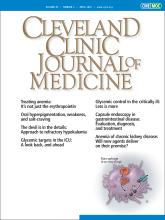Article Figures & Data
Tables
Professional society Year Recommendations American Diabetes Association70 2021 Insulin therapy should be initiated for treatment of persistent hyperglycemia at a threshold 180 mg/dL.
Once insulin therapy is started, a target blood glucose range of 140–180 mg/dL is recommended for most critically ill patients.
More stringent goals, such as 110–140 mg/dL, may be appropriate for selected patients if they can be achieved without significant hypoglycemia.American College of Physicians71 2014 Best practice advice 1: Clinicians should target a blood glucose level of 140–200 mg/dL if insulin therapy is used in surgical or medical patients in the intensive care unit.
Best practice advice 2: Clinicians should avoid targets < 140 mg/dL because harms are likely to increase with lower glood glucose targets.Society of Critical Care Medicine72 2012 A blood glucose level ≥ 150 mg/dL should trigger initiation of insulin therapy, titrated to keep the level < 150 mg/dL for most adult intensive care unit patients, and to maintain blood glucose values absolutely < 180 mg/dL using a protocol that achieves a low rate of hypoglycemia (blood glucose ≤ 70 mg/dL) despite limited impact on patient mortality.






